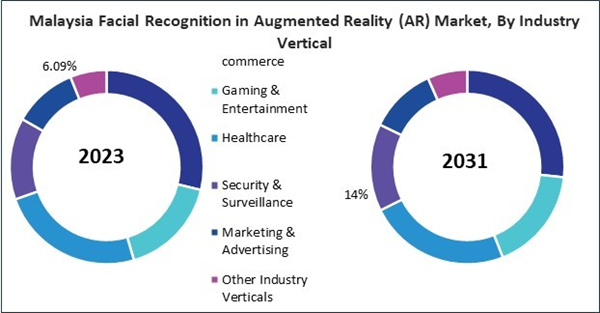The China market dominated the Asia Pacific Facial Recognition in Augmented Reality (AR) Market by Country in 2023 and is expected to continue to be a dominant market till 2031; thereby, achieving a market value of $39.68 billion by 2031. The Japan market is registering a CAGR of 53.2% during 2024-2031. Additionally, the India market is expected to obtain a CAGR of 55.2% during 2024-2031.
Museums and historical sites can employ facial recognition to enhance storytelling. As visitors approach exhibits, AR can recognize their identities and present customized narratives, or historical facts based on their background or interests. Facial recognition in smart home devices can enhance user convenience. AR can provide personalized interfaces based on who is present, adjusting lighting, entertainment systems, and climate controls to suit individual preferences.
Several factors have influenced the adoption of facial recognition technology in AR. As consumers increasingly seek personalized experiences across digital platforms, businesses are adopting facial recognition in AR to meet these expectations. Companies can enhance engagement and foster loyalty by tailoring content and services to individual users. The rapid evolution of AI and machine learning algorithms has made facial recognition systems more accurate and efficient. This technological progress facilitates smoother integration with AR applications, driving broader adoption across various industries.
As per the Australian Bureau of Statistics, these companies saw a staggering 98.7% increase in total revenue, climbing from $2.27 billion to $4.57 billion between 2015-16 and 2021-22. In comparison, the combined revenue of subscription broadcasters and channel providers has fallen short, highlighting the flourishing nature of film and video production in the Australian landscape. This growth indicates a vibrant sector ripe for technological innovation, particularly in augmented reality (AR) and facial recognition technology.
Moreover, the substantial increase in total expenses for film and video production companies, which rose by 131.1% to reach $4.90 billion during the same period, reflects a commitment to investing in cutting-edge technology and creative solutions. This willingness to invest can lead to increased adoption of facial recognition systems in AR applications, facilitating advanced storytelling techniques and personalized content delivery.
Integrating facial recognition technology into AR can offer distinctive opportunities for audience engagement as filmmakers and content creators seek to differentiate their projects in a competitive market. In conclusion, the growth of facial recognition in the augmented reality market is expected to be significantly influenced by the burgeoning gaming industry in India and the rising media and entertainment industry in Australia.
List of Key Companies Profiled
- Blippar Group Limited
- Apple, Inc.
- Clarifai, Inc.
- Cognitec Systems GmbH (Salto Systems, S.L.)
- Meta Platforms, Inc.
- Google LLC
- Qualcomm Incorporated (Qualcomm Technologies, Inc.)
- Amazon Web Services, Inc. (Amazon.com, Inc.)
- Microsoft Corporation
- Zebra Technologies Corporation
Market Report Segmentation
By Technology
- 3D Facial Recognition
- AI-Powered Facial Recognition
- 2D Facial Recognition
- Other Technologies
By Device Type
- Smartphones & Tablets
- AR Headsets & Glasses
- Kiosks & Interactive Displays
- Other Device Types
By End User
- Enterprises
- Public Sector
- Individual Consumers
- Other End Users
By Industry Vertical
- Retail & E-commerce
- Gaming & Entertainment
- Healthcare
- Security & Surveillance
- Marketing & Advertising
- Other Industry Verticals
By Country
- China
- Japan
- India
- South Korea
- Singapore
- Malaysia
- Rest of Asia Pacific
Table of Contents
Companies Mentioned
- Blippar Group Limited
- Apple, Inc.
- Clarifai, Inc.
- Cognitec Systems GmbH (Salto Systems, S.L.)
- Meta Platforms, Inc.
- Google LLC
- Qualcomm Incorporated (Qualcomm Technologies, Inc.)
- Amazon Web Services, Inc. (Amazon.com, Inc.)
- Microsoft Corporation
- Zebra Technologies Corporation









